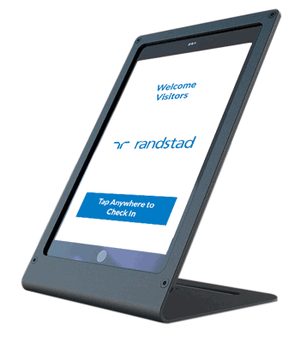Executive Summary:
- A good customer sign-in experience is vital because it creates an excellent first impression. That means a bad customer check-in process...
- If you want customers to have a terrible check-in experience, don’t greet them in a timely manner, neglect to ask their name or purpose of visit, make them wait longer than average, and put off telling them when you’ll serve them.
- Some ways to avoid back check-in experiences include hiring extra staff or using technology to stretch your workforce further.
You have been there. The receiving end of a terrible check-in experience. You don't know how to check-in. Once you do, it is unclear what will happen next. You see employees chatting amongst themselves. Meanwhile, the queue is piling up. Did that person just walk in and get service before you did?
Whether you operate a retail store, a government agency, or a medical office, it's imperative to audit your own customer check-in experience to ensure you do not follow these bad habits. Whether it's dropping in unannounced or hiring secret shoppers, you need to know how your visitors feel. It could be the difference between receiving bad reviews or creating champions for life.
Why a Good Customer Sign-In Experience Is Important
The checking-in process is the first interaction a visitor will have with your organization. Every visitor checking in your workplace or business premise is a potential customer, so the stakes could not be higher. Therefore, a good customer sign-in experience is vital for the following reasons:
Creates Good First Impression
Since it is the first interaction guests have with your business, a great sign-in experience creates a positive first impression of your company. One can’t stress enough that potential customers might reconsider transacting with your business if you make a poor impression.
For that reason, every facet of your sign-in process, from the receptionist to the lobby layout, should be single-track-minded towards assuring customers that you will serve them quickly. It would help to consider a virtual receptionist as it takes a shorter time to receive guests and process their details.
More Efficient
An excellent reception system will always be more efficient, ensuring visitors spend less time in the lobby and more time consulting over a business deal.
That’s why it pays to implement customer check-in software. It increases efficiency by letting hosts and guests know who is next on the queue. It can also segment customers by why they are visiting, for instance:
- Cash transaction versus opening a new account in a commercial bank.
- Sales versus support in a mobile phone store.
- Regular checkups as opposed to a test or procedure in a medical clinic.
- Know whether a visitor is a hiring company or an interview candidate at a recruiting or staffing agency.

What NOT to Do During Customer Check-In
To avoid lousy check-in experiences, here’s what NOT to do during the customer checking-in process.
Take a Long Time to Greet Customers

The worst thing you could do during the sign-in process is to take too long to greet and welcome customers. Take too long to greet customers appropriately, and they will assume you are not interested in transacting with them.
Welcoming customers the instant they enter a store shows that you care about them. Stand up, smile, and greet customers while maintaining eye contact and upright posture to give a good first impression.
Not Asking Who They Are
After greeting a customer, the next step should be finding out who they are. Not knowing your customers and failing to address them by their actual name shows you don’t care about who they are.
Please introduce yourself, then ask their name. Getting to know your customers creates a good rapport.
Don’t Ask Why They Came
Many receptionists fail to find out why a guest is visiting, simply pointing to a seat. That mostly happens when the guest says they need to see someone who is currently busy.
Sure, customers ask for someone because they are sure they will solve their issues. But you have to find out precisely what they need as someone else could competently solve the problem, helping them avoid wait times.
Not Informing Them When You Will Serve Them or What Happens Next
Customers expect fast service, but sometimes that is not always possible. Informing your customers when you will serve them helps minimize perceived wait time.
In case of delays, customers will become impatient if you fail to let them know when exactly you will serve them. If this might be the case, you should inform them in advance of some options of how to use their downtime. And how they will be notified when their turn in the queue is coming up.
Make. Customers. Wait.
 Nobody likes waiting, especially if they are last in line. Considering Americans wait 118 hours to receive services every year, it’s no surprise some might walk out before you serve them.
Nobody likes waiting, especially if they are last in line. Considering Americans wait 118 hours to receive services every year, it’s no surprise some might walk out before you serve them.
That’s probably because making customers wait shows you don’t value their time. If you inform a customer that you will serve them in 5 minutes, ensure you attend to them at the designated time.
What to Do During Customer Check-In
How you check in your customers determines their experience and the likelihood of them transacting with you. Bend the rules and spare no expense to ensure you handle potential customers appropriately and protect your corporate image, and this is how to go about it:
Option 1 - More and Better Staffing
During busy periods, hire extra staff to assist in checking-in customers. It will make the signing-in process faster and improve the customer experience.
Additionally, make sure you provide excellent training to ensure success. This should include general customer service knowledge and specific information about your line of business. Since we all need mentorship and outside insight on occasion (or more often), augment staff with supervisors that can review and provide pointers on improving the efficiency of the sign-in experience.
Option 2 - Utilize Technology
 Manual checking-in is hectic, especially during busy periods. Consequently, you will find it challenging to identify who is next in the queue, mix up customers’ identities, or worse, misplace the sign-in book.
Manual checking-in is hectic, especially during busy periods. Consequently, you will find it challenging to identify who is next in the queue, mix up customers’ identities, or worse, misplace the sign-in book.
Instead, use a queue management software system. These customer sign-in systems are a cost-efficient way to handle an unlimited number of customers. Not only is the visitor experience contactless and stress-free, but it can also provide additional information for data analysis. For example, throughput and which employees see the most guests.
Perhaps most importantly, customer check-in systems give you a tool to communicate with people after their visit. Want to automate exit surveys? Or add them to your marketing database? These tools make this a breeze.
Final Word – How Not to Do Customer Check-In
All visitors expect when trooping into your business premises is reception competence to ensure their visit is fast, smooth, efficient, and, just to drive the point home, fast.
The last thing you should do during the customer check-in is the opposite of that. That includes not greeting or welcoming guests fast enough, not inquiring about the purpose of their visit, failing to state when you’ll serve them, or making them wait longer than promised.
The check-in processes should be customer friendly, prioritizing the customers’ experience. Making your customers’ check-in experience a priority will boost your company’s image.